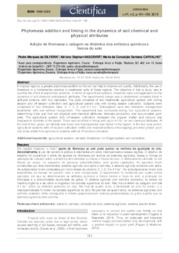Phytomass addition and liming in the dynamics of soil chemical and physical attributes.
Phytomass addition and liming in the dynamics of soil chemical and physical attributes.
Autoria: SILVEIRA, P. M. da; NASCENTE, A. S.; CARVALHO, M. da C. S.
Resumo: In tropical regions, a greater phytomass addition to the soil can help to improve soil quality. Additionally, the use of limestone is a fundamental practice in weathered soils of these regions. The objective of this is study was to quantify the effect of phytomass additions in terms of agricultural systems, limestone rates and application on the dynamics of soil chemical and physical attributes. The experimental design was a randomized complete block in split-plot scheme, with four replicates. The plots consisted of two treatments: agricultural system with raining season and off-season cultivation and agricultural system only with raining season cultivation. Subplots were composed of five limestone rates: 0, 1, 2, 3, and 4 t ha-1. Subsubplots were two limestone management treatments: with and without incorporation. The experiment was conducted during four agricultural seasons, determining initial and final soil physical and chemical attributes, biomass production, and accumulated grain yield. The agricultural system with off-season cultivation increased the organic matter and calcium and magnesium contents in the topsoil. There was no effect of liming with up to 4 t ha-1 on soil chemical attributes. At the end of four years, soil density was lower and macroporosity was higher in the topsoil. In the four-year period, agricultural systems with off-season cultivation (millet and maize/brachiaria intercropping) provided greater grain and straw yields than agricultural systems without off-season cultivation.
Ano de publicação: 2019
Tipo de publicação: Artigo de periódico
Unidade: Embrapa Arroz e Feijão
Observações
1 - Por padrão são exibidas publicações dos últimos 20 anos. Para encontrar publicações mais antigas, configure o filtro ano de publicação, colocando o ano a partir do qual você deseja encontrar publicações. O filtro está na coluna da esquerda na busca acima.
2 - Para ler algumas publicações da Embrapa (apenas as que estão em formato ePub), é necessário ter, no celular ou computador, um desses softwares gratuitos. Sistemas Android: Google Play Livros; IOS: iBooks; Windows e Linux: software Calibre.
Acesse outras publicações
Acesse a Base de Dados da Pesquisa Agropecuária (BDPA) para consultar o acervo completo das bibliotecas da Embrapa.

